
Kiyomizu Dera is one of the most celebrated Buddhist Temples in Japan, that attracts 4 millions of visitors a year. It was established in year 778 during early Heian period, before Kyoto became the national capital. It situates at the site of Otowa Waterfall at the forested hills east of Kyoto. The name of this historical temple Kiyomizu which means pure water, was derived from the spring water that falls from the mountain. The complex suffered fires attack many times in the past centuries. Most of the present structures were restored within year 1631 to 1633 in early Edo period by The 3rd Shogun Tokugawa Iemitsu. Kiyomizu Dera used to belong to the oldest schools of Japan Buddhism Hosso Sect but after 1965, it formed its own Kita-Hosso sect.



The Deva Gate Niomon that houses two guarding Devas on both sides was built in 15th century. It is one of the imposing structures within the temple ground.



Kiyomisu Dera is famous for its fall and spring illumination at night. The opening date depends on each seasons. This year the fall illumination begins on 15th November, the date when we were going to leave the city.



There are 15 structures standing in the lush precincts, some of which were survived since it was restored in 16th or 17th century. The Deva Gate, West Gate, Bell Tower, Sanjunoto 3-tiers Pagoda, Hondo Main Shrine Hall and its stage, Okuno-in Hall, Amitaba Hall, Gautama Buddha Hall and Otowa Waterfall Pavilion are some of its important cultural properties. At the moment, many of the front buildings were wrapped up for renovation.


Tamura Founder's Hall, Kaizen-do Hall and Asakura Hall are the few structures standing behind Deva Gate.


Within its precinct, you also can find Kyodo Sutra Hall and Zuign-do Hall that dedicated to the mother of Buddha.



There are different versions relating to Legend of Kiyomisu Dera Temple but I choose to believe this one:- It was said that Kiyomisu Dera was found by a Nara monk named Enchin who practiced asceticism. He met a Buddhist old recluse called Gyoei Koji while wandering nearby Otowa-ni-taki, to look for a site with golden stream to build temple, after being inspired in a dream. Gyoei told him that he was a devotee to Kannon Bodhisattva and had been waiting for him to come as he was to leave. He presented the monk a piece of wood log and left. Monk Enchin soon found a pair of sandals on top of the hill and realized that the old hermit was a Bodhsattva. The monk later created an image of eleven headed thousand armed image of Kannon and carved it on the sacred log given to him by Gyoei, and built a little hut to house it. One day, General Sakanone Tamuramaro(758-811) happened to pass by the water fall when hunting a deer. He met Enchin. Seeing him killing a deer and carrying it in hand, the monk delivered him a Dharma talk and lectured him with merciful teaching of Kannon Bodhisattva. General Tamuramaro repented and became a pious disciple to Enchin, devoted and in faith to Kannon. He donated a proper hall to enshrine the image of Kannon by dismantling his own house and in year 794, he contributed to the master The Emperor's old residence that was gifted to him after the emperor built a new palace when moved to Kyoto. The building was made into the main shrine hall of the temple.



The best attraction at Kiyomizu-dera temple site is its Main Shrine Hall Hondo that built on the steep slope with its wooden stage viewing corridor. This national treasure of Japan was restored in year 1633. The Hall enshrines with an ancient little eleven headed wooden image of Kannon Bodhisattva with thousand arms. It is only opened for public 33 years once or in some special occasions. I was very blessed to have paid homage to the image during my first visit many years ago.


The corridor offers a spectacular view of Kyoto city as well as beautiful sights of cherry trees blooming in spring and colorful fall foliage brightening in autumn, at and below the hill.





Otowa-san Kiyomizu-Dera is the official name of the temple. It is part of the historical monuments of ancient Kyoto and a world heritage site of Unesco.


The floor of Stage corridor were installed with 410 cypress boards and supported by 139 twelve meters high Keyaki pillars, without using a single nail on the construction.



The bright Koyasu-no-to pagoda at front distance of The Stage Corridor looks gorgeous.


Kiyomisu Stage Corridor and the veranda at Okunoin Hall are spectacular vantage point to overlooking the city of Kyoto.


The distance view of Kyoto city in dusk
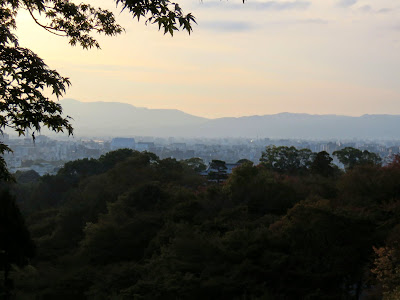

View of the construction structure of the huge pillars that jutted out over the precipice and supported the vast veranda of Kiyomizu-Dera Main Shrine Hall.
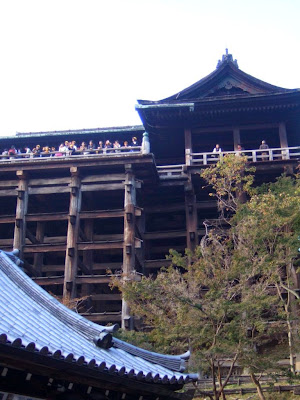


Jumping off the Stage at Kiyomisu-dera was one of the sayings from Edo period (1603-1867), meaning doing things with absolute resolve or grave determination as it was said that if one were to jump down from the stage and survived, he would be granted with what he wished.


Light an incense, hit the bell at the roof eave, or shake out a fortune wishing sticks and tied the fortune slips at the corridors are ways of making wishes by the local worshipers in the temple. I just hope Kannon Bodhisattva can hear them and make all their dreams come true.



Jishu Shrine dedicating to God of love and marriage is one of the most visited structure at site. It stands behind The Main Shrine Hall.
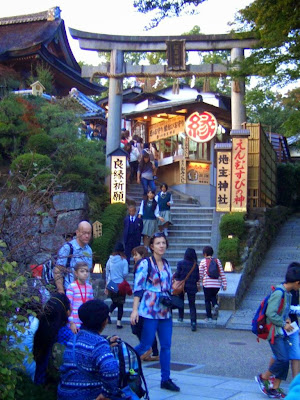


Kiyomisu-dera is a Buddhist Temple site and contrarily, it has a shrine within its enclosed precinct, where people praying to look forward for a love or marriage!


This is the most favorable place for youngsters and singles




The red character read as "Yuan" which means affiliation. Asians especially Chinese, Buddhists or non-Buddhists, believe that every matter has its "yuan" particularly applied to the human relationship.


The wooden rack at the corner near the garden is a place for people to tie wishes written plague. It was believed that the deity here has the power to assist them in love affair.



There are two stones placed 18 meters apart in front of Jishu Shrine. It was believed that if one is able to find its way from one stone to another with eyes closed, he/she can have luck to find a true love. You either can pay 800 yen to get a wooden plague and write down your wish then tie it at the rack, and waiting for your love to come.



Otowa Waterfall is at the base of Kiyomizu Main Shrine Hall. Water flowing down are divided into three sacred flows, representing health, longevity and academy success. Sterilized long pole ladle are ready for people to obtain the water from the individual flows to drink or wash the face and most important, to receive the benefits.


The water brings you health, longevity and academy success, you believe or not, does not matter. It is fun to try yourself and watch others enjoying it.



The site of Otowa Fall.

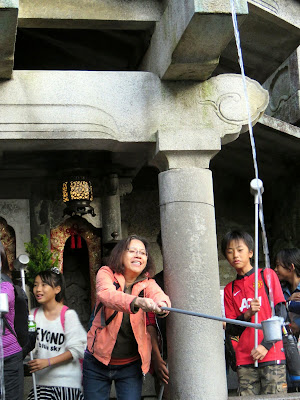

Visiting historical sites is part of Japanese teaching curriculum. Crowds of student wearing the identified yellow cap like herd of bees gathered at Otowa Fall in Kiyomisu Dera Temple.


With all these angel young kids around, though noisy and bustling but joyful and lively.


We unexpectedly met an elegant standing stone carved Earth Stored Bodhisattva Dizang image at the edge of the wooded hillside.



How nice if we have time to enjoy a cup of their macha tea at this cozy tea house in the open area at the temple site!


A corner of the garden.



The pagoda makes the sight attractive to all photographers.



Women in Kimono looks elegant and beautiful.



The entire mountain will erupt in a sea of bright red hue in another 7-10 days time. We may miss the peak but we definitely enjoy the present.


A spectacular sight of mid autumn foliage at Otowa Mountains.


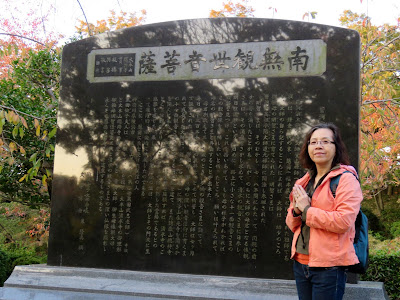

Kannon is the Bodhisattva of compassion, commonly known as Goddess of Mercy and in Sanskrit, as Avalokitesvara which means Observer of the sounds of the world. In Mayahana Buddhism, he is the disciple and future successor of Buddha Amitabha in The Western Pure Land, and is one of the four important greatest Bodhisattva. Phrases carved on the rock are extracted from the The Dharma Flower Sutra.



No comments:
Post a Comment